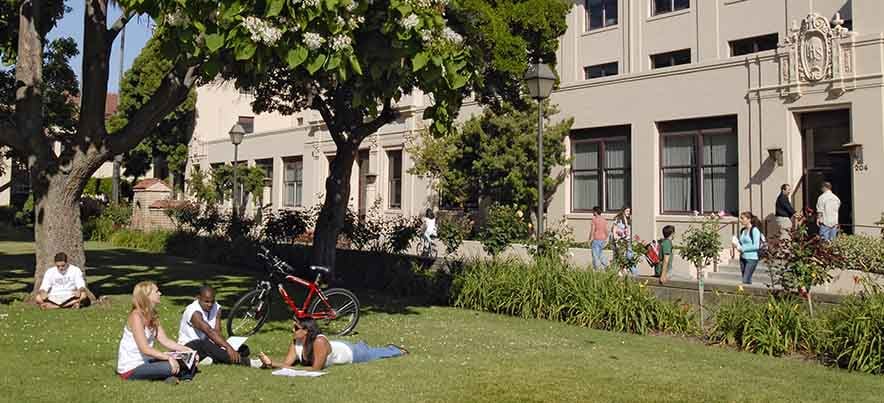Campus ID Gets a Makeover
Santa Clara University (SCU), a Jesuit school founded in 1851, is located in the heart of Silicon Valley, a California region well known for cultivating advancements in technology. It is appropriate, then, that the university is embracing the latest in near field communication (NFC) technology to secure its campus residence halls.
The SCU ACCESS card is the campuswide ID program that allows students and faculty to pay for vending, printing, meal services, and more using the card’s magnetic stripe technology. Nirmal Palliyaguru, director of the ACCESS card office and conference services at the university, says that linking residence hall access to the cards for the 2,800 students that live on campus was a goal he had for many years.
Palliyaguru notes that Santa Clara rebrands its ID card program every 10 years. In 2009, Palliyaguru’s supervisor approached him about the roadmap for the upcoming rebranding. Palliyaguru saw an opportunity to incorporate access to residence halls with the ID card program using NFC technology. He says that the convenience and security NFC technology provides were the two main drivers of the decision.
At that time, all 16 residence buildings on campus used traditional locks and keys. If a key was lost, there was no way to guarantee a student’s safety in his or her own room without changing the lock completely. Using NFC locks would mean increased security, in addition to convenience. “We’re a pretty safe campus. But that doesn’t mean much–all it takes is one thing to happen,” he notes. To achieve this goal, the university would need to find a secure chip provider for a contactless solution, in which users would wave their cards over a panel by the door to gain access.
Palliyaguru suggested partnering with Sony to use its FeliCa contactless IC chip. The campus uses Blackboard Transact as its card provider, and a magnetic stripe on the back of those cards enables the payment services. Blackboard had never used the FeliCa technology in its cards, but decided to partner with SCU to perform a pilot. The company also recommended that Santa Clara use the SALTO door access system for its lock hardware.
A contactless token resides in the campus ID card, enabling a user to simply hover his or her card over the reader on the SALTO lock. A signal is sent to the main server, which sends a signal back to the lock, allowing access. The FeliCa chip is encrypted for secure communication to and from the lock, and all necessary security access levels are defined in the SALTO server, notes Palliyaguru. This means that student access to individual dorm rooms can be managed with ease. The card office worked with housing auxiliary services and IT to use existing network switches and ports for the SALTO technology.
During the pilot phase in 2011, the university installed 80 SALTO locks at one of its smaller residence halls.
Most recently, in the summer of 2014, the university was adding a center structure to combine two residence halls, and Palliyaguru saw the opportunity to incorporate the SALTO locks once more. The same year two additional residence halls were upgraded, adding more than 300 locks. Now 800 doors across campus have been fitted with SALTO locks.
All the SALTO locks are managed on one server. From there, any hardware or card failures can be observed and promptly resolved. To further enhance security, any access changes are pushed out to specific card readers, known as hotspots. Students have to go to one of more than 20 hotspots on campus every five days to update their card by hovering it under a scanner. It sends a signal to the server and back to the card, keeping it activated for another five days. “If not, your card will not work,” Palliyaguru notes. If a card is lost or stolen, students can report it to campus safety at any time and get a replacement.
The door lock has a battery that can be monitored online. If the battery dies, and access is needed, there is a patented process developed by SALTO, revealed only to campus law enforcement and maintenance staff, to defeat the lock and gain entry.
Due to the success of the program, SCU will be migrating to the SALTO solution in all 16 of its residence halls within the next two to four years. “We’re making a very aggressive approach to move our residence halls away from other systems to go with SALTO as our benchmark,” says Palliyaguru.
SCU has also been beta testing a phone-driven credential on Android platforms, Palliyaguru says. This would allow students to use their phones with the SALTO locks and conduct transactions at payment terminals. Palliyaguru says they hope to have it launched in the near future.
From an operational point of view, Palliyaguru says he was nervous about students possibly abusing the technology, because the cards are more expensive that the previous magnetic stripe cards. However, he was pleasantly surprised. “They know if they break it, then they’re going to pay for it before they can get into their rooms,” he notes. “Looking at a random sample of the kids that live in the [upgraded] residence halls, they take better care of their cards than the other students.”
